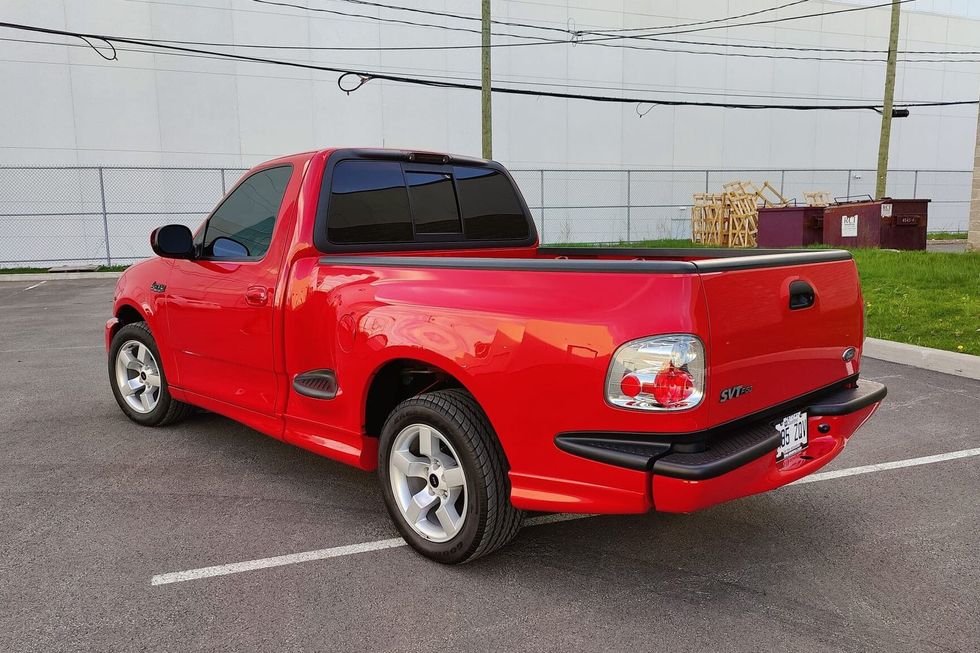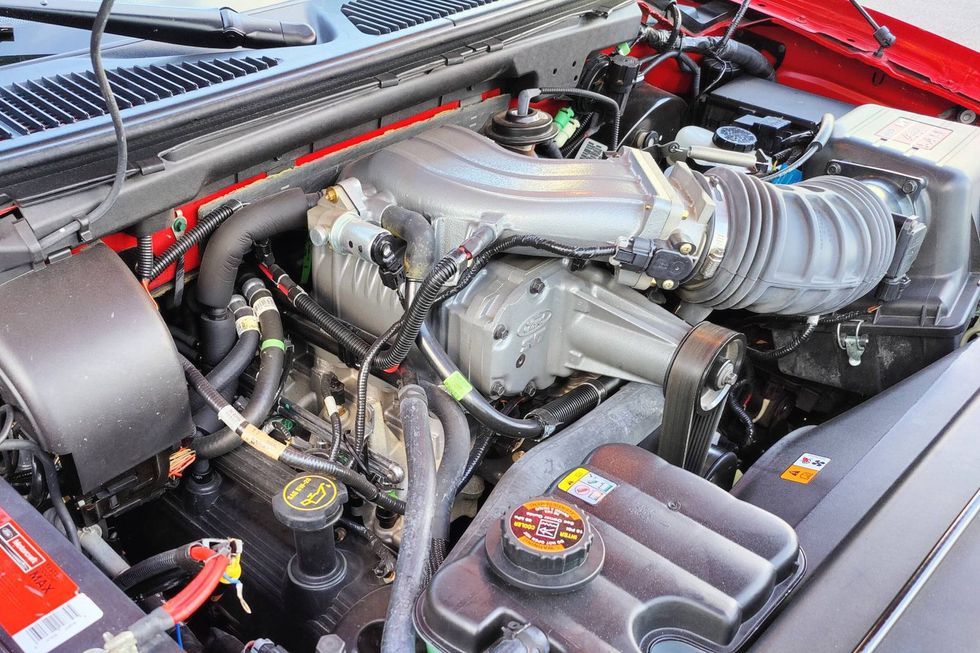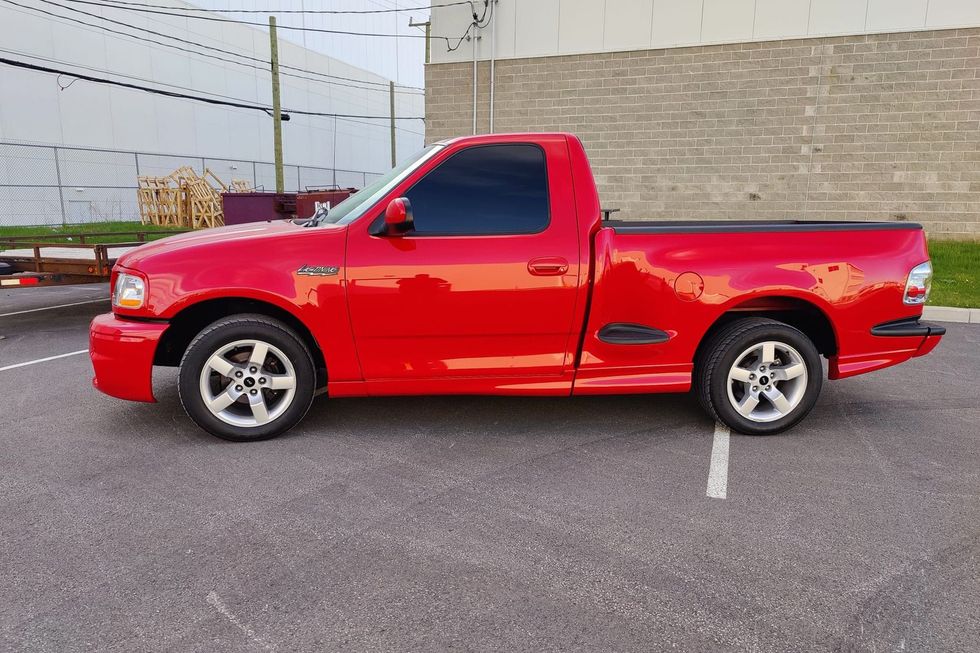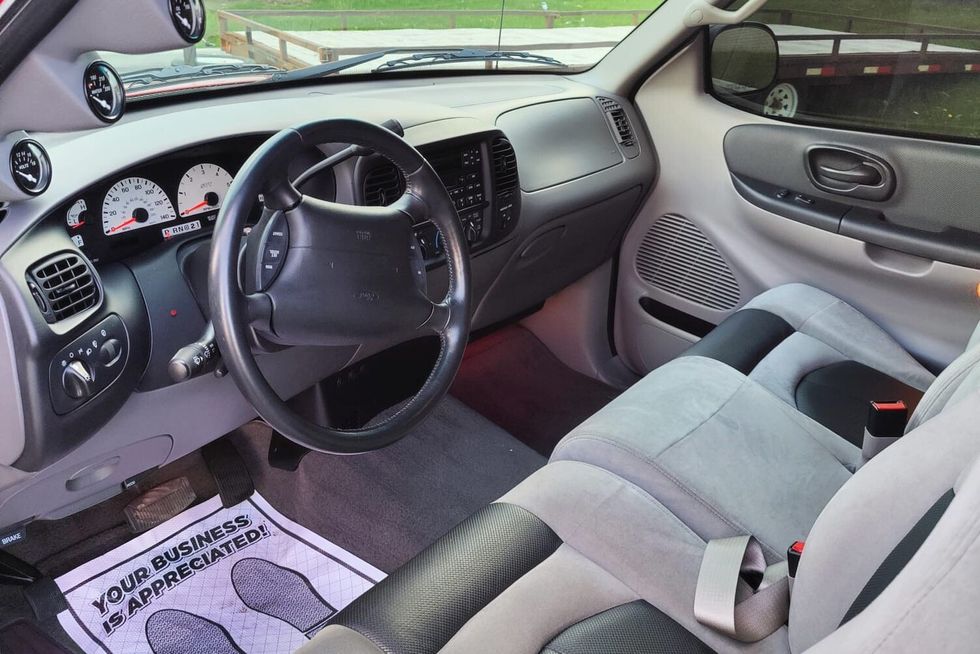
Buy
Resources
Entertainment
Magazine
Community
In This Article
Category:
Hemmings Motor News
In the midst of the Great Depression, Buick had somehow managed to fall from third in the industry to a lackluster eighth. Although the automobile industry as a whole suffered, it's been theorized that the Flint automaker's decline was attributed to their designs of the early 1930s. Yet Buick's higher price structure certainly had a lasting effect, especially when the B-O-P dealer network could sell more affordable Pontiacs at a faster rate. Whatever the reason, there are many collectors today who appreciate the fine Flint styling and increased horsepower of this troubled era, such as this 1933 Model 57 sedan.
Now in their fourth season, having replaced the Series 121, Series 50 models were slightly refreshed in the form of a longer 119-inch wheelbase frame, complete with a new, much stronger "X" crossmember. Although the semi-elliptic leaf-sprung suspension system supporting it seemed unaltered, the length and number of individual leaves within each front spring assembly were altered to compensate for the wheelbase alteration; the front I-beam axle was accompanied by king pins. Internal expanding mechanical brakes were still in use, with 12-inch drums, which could have been hidden behind steel wire or steel artillery-style wheels.
Rounding out the mechanical aspect of the Series 50 was a straight-eight engine, now punched out to a more powerful 230.4 cubic inches, that was rated at 86hp and roughly 173-lbs.ft. of torque; fuel was delivered via a Marvel updraft carburetor. Bolted against the engine was a synchronized three-speed manual transmission with a first gear ratio of 2.895:1, which was then linked through the use of a torque tube to a spiral bevel differential with semi-floating axles and a ratio of 4.70:1.
Complementing the lengthened wheelbase was a slightly stretched body--enhancing the flowing lines--yet Buick engineers managed to lower overall height by 2.25 inches. Buick literature touted a new veed grille design and, specific to sedans, a gracefully curved rear panel dubbed "beavertail" styling. This new body still employed the old-school method of construction: steel panels over wood frames, with stretched fabric protecting passengers from the elements; floors were still thick, wooden slats. Sedan doors, meanwhile, were hinged at the center post.
Each Model 57 sedan was available only in five-passenger configuration, the seats of which were covered with mohair upholstery. A full complement of gauges was provided--speedometer, ammeter, water temperature, oil pressure and even an electric fuel gauge were positioned within a steel panel trimmed by a chrome strip. An elegant flair was enhanced by woodgrain beyond the gauge panel, which carried over to everything from the window surrounds to the ash receivers.
At the conclusion of the model year, the Model 57 sedan proved to be Buick's biggest seller for the third year running with 19,109 copies; Buick's total model year production ceased at 43,247 units.
Recent
Forget Ford’s groundbreaking electric truck for a moment to consider this 2001 Ford SVT F-150 Lightning now offered on Hemmings Auctions. Instead of the dual permanent-magnet motors found in the current electric Lightning, the 1999-2004 SVT Lightning featured a supercharged version of Ford’s 5.4-liter “modular” OHC V8. Rated at 380 horsepower in the 2001-’04 models, it was good enough to make a stock lightning a formidable opponent on the street as well as at the strip.
A follow-up to the original 1993-’95 F-150 Lightning, which was a high-performance version of a standard F-150, the second-generation SVT super truck presented as a more thoroughly developed model with a lot more exclusive components that further differentiated it from the rest of the F-Series lineup. Beyond the engine, the entire suspension and braking system, not to mention aerodynamic body add-ons, were part of the Lightning package from 1999 through 2004. Exclusive interior components were also part of the package.
Boosted Powertrain
At the heart of this SVT Lightning is its iron-block 5.4-liter SOHC, 16-valve V8 with a supercharger and an intercooler. The blower helped it deliver 380 horsepower and 450 lb-ft of torque in 2001, up some 20 horsepower and 10 lb-ft from the ’99 and 2000 models. The Eaton supercharged engine delivered peak boost of 8.0 psi and the engine featured an 8.4:1 static compression ratio, down from the standard 5.4 V8’s 9.0:1, which was rated at 260 horsepower and 350 lb-ft.
Power reached the rear 18-inch cast aluminum-alloy wheels via a four-speed automatic, an aluminum driveshaft and a beefy 9.75-inch, limited-slip rear axle with an acceleration-friendly 3.73:1 final-drive ratio, another upgrade for 2001. Car and Driver magazine reported a 0-60 mph time of 5.2 seconds and a quarter-mile in an E.T. of 13.8 seconds at 104 mph—impressive numbers for a 4,600-pound truck. Top speed was a drag-limited 142 mph.

A Truly Sporting Truck
Trucks generally require a suspension that can handle a full load in its bed while also providing competent driving while empty. But if you fancy one designed to a sports-car standard, then something has to give. In the case of the second-gen Lightning, Ford dropped its payload capacity to a mere 800 pounds. A standard 2001 F-150 Styleside carried a 3,180-pound payload rating, while an F-150 Flareside was rated at 2,005 pounds, some two-and-a-half times the Lightning, which featured the short-bed Flareside body. Towing capacity, likewise, was reduced from 8,800 pounds to 5,000 in the Lightning. But the Lightning’s strengths were never its payload or towing capacities, but it’s ability to perform like a sports car.
As a 21st century performance vehicle, however, the second-gen Lightning was also equipped to handle. A half-inch drop at the front was accompanied by SVT-specific coil springs and Bilstein shocks along with an exclusive 31-mm solid anti-roll bar. SVT’s influence continued at the rear with Lightning-specific five-leaf springs and a 23-mm solid anti-roll bar. The Bilstein setup at the rear included the right-rear shock staggered toward the front of the truck to reduce axle hop under heavy acceleration. The four-wheel antilock disc brakes were cribbed from the three-quarter-ton F-250, with 12.1-inch front rotors at the front and 13.1-inch discs at the rear.

As the years go on, fewer and fewer clean, unmolested low-mileage examples are out there, which is why this 2001 Ford SVT F150 Lightning now on Hemmings Auctions caught our attention. Showing just 5,525.5 miles on its odometer at the time of submission, it is said to be in “mint” condition and have an “immaculate” finish in the seller’s words. No modifications are noted to any part of the vehicle. The 18-inch factory alloys don’t appear to have any curb rash, though the Goodyear performance tires may be original. About the only deviations from stock are the tinted windows.
The latest electric-only F-150 Lightning is certainly a quick vehicle in its own right, but this 2001 edition from the engineers at SVT was built for excitement, not range. It was made with an old-school muscle-car vibe along with modern handling and braking. Which Lightning would you look good behind the wheel of?
Take a look at this second-gen Lightning on Hemmings Auctions before the bidding ends.

Keep reading...Show Less
Spring is here. As the snow melts and the daffodils bloom, it’s time for many vintage cars to emerge from winter hibernation and get back on the road. Thinking of adding to the collection? We have 10 vehicles in spring-like shades of yellow – including cars and trucks, U.S. and European – to catch your eye.
1976 AMC Matador
<p>Yellow is a classic 1970s color and while we resisted the temptation to go for a Pacer, this unusual <a href="https://www.hemmings.com/classifieds/listing/1976-amc-matador-ruskin-fl-2738072" target="_blank">1976 AMC Matador Coupe</a> kicks off the list. Sunshine Yellow is the shade used here, complemented by a white vinyl roof and some brown plaid upholstery that also betrays its decade of origin. Aluminum five-spokes and whitewall tires complete the look.</p><p>For sale in a classified ad for $13,000, the unrestored Matador isn’t perfect – the A/C and horn apparently don’t work and there is some “rust, albeit “minimal”. But the car is said to be complete and drivable as-is, complete with a 256 cubic-inch (4.2-liter) inline-six under the hood and a three-speed automatic.</p>





1978 Ford Bronco Ranger XLT 4x4
<p>From the unrestored to the immaculate. Listed with a dealer in Plymouth, Michigan, this custom,<a href="https://www.hemmings.com/classifieds/listing/1978-ford-bronco-plymouth-mi-2771499" target="_blank"> Bright Yellow Bronco </a>with removable white hardtop has been subject to a frame-off build. The front buckets and rear bench are finished in saddle brown with tan accents while the upgraded dash features Dakota Digital gauges, a modern radio and controls for the Vintage Air A/C.</p><p>Based on a 351M V-8, the 408 cubic-inch (6.7-liter) engine has an Edelbrock aluminum intake and heads, Quickfuel 750-cfm 4BBL carburetor, MSD ignition and Erson roller camshaft. It sends 452 bhp to the pavement through a Ford C6 automatic transmission, NP205 transfer case and Dana 44 (front) and Ford 9-inch (rear) axles. The truck has a 5-inch lift, Fox shocks and aluminum mag wheels shod with Dick Cepek Trail Country EXPs.</p>





1965 Bizzarrini 5300 GT Strada
<p>The reborn Bizzarrini company has recently been selling 24 modern recreations of its iconic 1960s GT, called the 5300 GT Revival Corsa. But the yellow 1965 car listed here is the real deal, designed by the eponymous former Ferrari engineer with styling by Giorgetto Giugiaro and Piero Drogo.</p><p>The <a href="https://www.hemmings.com/classifieds/dealer/bizzarrini/5300-gt-strada/2771352.html" target="_blank">Bizzarrini 5300 GT Strada</a> was a race car for the street, with lightweight aluminum bodywork, fabricated platform chassis and a semi-monocoque body riveted to the frame. The yellow Strada offered here for €1,150,000 (about $1.25m) offers the best of both worlds: it’s still street legal in its home country of the Netherlands but was prepared for racing in 1997 and has competed all over Europe ever since.</p><p>Restored in 2007, the 5300 GT – powered by a front-mid-mounted, 5.4-liter Chevy small-block – has continued to race, despite subsequently changing owners, and is said to come with a comprehensive history file.</p>





1970 Dodge Challenger RT
<p>This <a href="https://www.hemmings.com/classifieds/listing/1970-dodge-challenger-auburn-ma-2775350" target="_blank">Challenger RT restomod</a> is finished in Pearl Yellow with White Diamond Gold Pearl accent stripes and painted graphics. According to the seller in Auburn, Mass., it was painted by legendary California painter Hershel ‘Junior’ Conway from Junior’s House of Color.</p><p>Originally built by Mr. Norm’s and included in the Grand Spaulding Registry, the car was later bought and rebuilt by Dick Landy Industries (DLI). The 440 cubic-inch (7.2-liter), 600-bhp engine has Mopar performance cams, lifters and roller rockers; Hooker long-tube headers; and a Flowmaster dual exhaust. It was recently rebuilt by Larry Ofria of Valley Head Service in Northridge, Calif.</p><p>The aluminum, three-link Panhard bar rear suspension was fabricated for this Challenger, which rides on 17-inch American Racing wheels. It has Brembo disc brakes, an RT hood and a high-performance radiator.</p>





1967 Alfa Romeo Duetto
<p>“Mrs. Robinson, you’re trying to seduce me!” The yellow on <a href="https://www.hemmings.com/classifieds/listing/1967-alfa-romeo-duetto-la-vergne-tn-2717183" target="_blank">this 1967 Duetto</a> – a year younger than the famous car from <em>The Graduate</em> – is not an original shade, but it looks great all the same. It’s matched on the dash and in the carpet piping.</p><p>Originally Ivory, the color was brightened up during a 2010 respray, part of a wider restoration of the Spider’s body in 2009-12. It currently has Euro headlight covers and aftermarket Cosmic wheels sporting Yokohama tires. The classic 1,600-cc, twin-cam motor is said to be “date-correct” and only has 100 miles since a 2022 rebuild. The five-speed manual was also done three years earlier.</p>





1985 Jeep CJ-8 Scrambler
<p>We turn to Saxon Yellow for this <a href="https://www.hemmings.com/classifieds/dealer/jeep/cj8-scrambler/2608603.html" target="_blank">rare CJ-8</a>, for sale at $35,900 from a dealer in Elkhart Lake, Wisc. Like the Alfa, the yellow paint is paired with a black interior – this time featuring cloth bucket seats and a custom locking console.</p><p>The Scrambler extended the CJ-7’s wheelbase to 103.5-inches and featured a pickup-style box behind the seats. Some 27,792 were manufactured from 1981-86, according to <a href="https://www.classic.com/m/jeep/cj/cj8" target="_blank">Classic.com</a>. This 1985 example has been fully restored. It has air conditioning, new American Racing Wheels and Goodyear Wrangler Duratec rubber, and a Fishbone Offroad front bumper with driving lamps.</p>





1997 Ferrari F355 Spider
<p>Yellow isn’t red, but it’s still a timeless Ferrari color. The F355 is a classic design, in our view, with Pininfarina evolving the look of the previous 348 to winning effect. This <a href="https://www.hemmings.com/classifieds/dealer/ferrari/355-spider/2767529.html" target="_blank">1997 Ferrari F355 Spider</a> in <em>Giallo</em> over black leather offers a route into Prancing Horse ownership for a shade under $100k, just below market average.</p><p>There’s peace of mind on the 3.5-liter V-8 from a full engine-out service completed last summer by Cecconi Motorsports. That brought a new clutch master cylinder, timing belts, drive belts, fuel filter, air filter, plugs, crank sensor and coolant hoses. The V-8 is paired with a six-speed gated manual.</p><p>Brembo GT drilled/slotted brake rotors, HRE three-piece wheels in satin black, a Tubi exhaust and a stainless fuel-line kit are all aftermarket upgrades. Jobs for the to-do list include a look at the pop-up headlight mechanism and a shock sensor light on the dash. There’s a clean Florida title and a Carfax report that records a “minor fender bender” from 1997 affecting the rear quarter.</p>





1974 Mercedes-Benz 450 SL
<p>The shade on this <a href="https://www.hemmings.com/classifieds/dealer/mercedes-benz/450sl/2772110.html" target="_blank">1974 SL</a> (color code 624) was simply called ‘Yellow’. This roadster is described as “an honest original example” of the long-running R107, with 120k miles on the clock: “a solid and straight car overall with a lot of potential”, in the seller’s words.</p><p>The manual-transmission Mercedes runs and drives but requires servicing and some minor cosmetic work – there are signs of what looks like corrosion on the trunk lid and around the base of the hardtop. Still, we think this is a classy ride for $10,950. What better way to celebrate spring than to get the top down on a classic Benz?</p>





1970 TVR Vixen 2500
<p>Restored to concours condition by David Zumstein of Abingdon West in Fallbrook, California, this <a href="https://www.hemmings.com/classifieds/dealer/tvr/vixen/2676227.html" target="_blank">Chrome Yellow TVR</a> is unique. As detailed in the definitive history of early TVR, <em>A Passion to Succeed</em> by Peter Filby, and as cited by the seller, this was the only Vixen 2500 to receive a Lucas fuel-injected Triumph TR5 engine and four-speed transmission with electric overdrive. US TVR importer Gerry Sagerman and company owner Martin Lilly obtained this unit from British Leyland when they went to secure a deal for TR6 powertrains for subsequent Vixens. Those engines were the US-certified, “smog special” straight-sixes with twin-Stromberg carburetors.</p><p>The historic Vixen is in beautiful condition, having been subject to a frame-off restoration. It has Spax adjustable shocks, a stainless-steel exhaust system, aluminum fuel tank and factory sliding sunroof. It rolls on its original finned alloy wheels, now fitted with Dunlop radial tires.</p>





1938 Studebaker K15M38 Cab-over
<p>Mustard Yellow is our final shade of yellow in this springtime rundown. A seller in Morgantown, Pennsylvania, is asking $162,500 for this <a href="https://www.hemmings.com/classifieds/listing/1938-studebaker-morgantown-pa-2750534" target="_blank">cab-over K15M38</a>, which was restored over 19 years, as documented in an accompanying photo album, and has won several awards at AACA and Studebaker events.</p><p>The wood-lined bed of this delivery truck has milk cans strapped into the stall area up front, as befits the signwriting for Whitney Farms of Northboro, Massachusetts. The cab oozes art deco-influenced style, inside and out. Beneath it, the 226 cubic-inch (3.7-liter) six-cylinder got new rings, bearings and valves during its rebuild. Continuing the theme of renewal, the rust-free chassis boasts new brake linings, hoses and fuel lines.</p>





Keep reading...Show Less
Interested in a new or late model used car?





